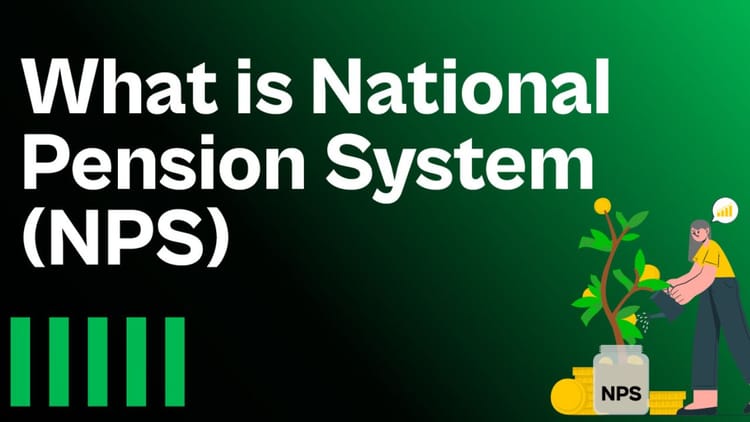OPS vs NPS vs UPS: Who is better for you?

- Pension schemes are vital for securing financial stability post-retirement, providing a steady income during old age. In India, multiple pension schemes have been introduced over the years to cater to various employment sectors and needs. Three of the most discussed pension schemes are the Unified Pension Scheme (UPS), New Pension Scheme (NPS), and Old Pension Scheme (OPS). In this article, we will explore the key differences between these pension schemes and their features, benefits, and other important details.
Overview of the Pension Schemes:
Unified Pension Scheme (UPS):
- The Unified Pension Scheme (UPS) aims to bring all pension schemes under one umbrella to provide seamless management and enhance beneficiaries' benefits. UPS is designed to offer a unified framework for government and non-government employees, simplifying the pension process.
New Pension Scheme (NPS):
- The New Pension Scheme (NPS), introduced in 2004, is a voluntary pension scheme open to all Indian citizens. It replaced the OPS for government employees who joined after January 1, 2004. NPS allows employees to contribute regularly towards their retirement fund, which is then invested in market-based securities, offering flexibility and market-linked returns.
Old Pension Scheme (OPS):
- The Old Pension Scheme (OPS) was the traditional pension system for government employees, which guaranteed a fixed monthly pension after retirement. OPS offered a defined benefit plan based on the last drawn salary, ensuring financial security without any investment risks. However, OPS has been discontinued for new government employees since 2004.

Key Features of the Pension Schemes:
| Feature | Unified Pension Scheme (UPS) | New Pension Scheme (NPS) | Old Pension Scheme (OPS) |
|---|---|---|---|
| Eligibility | All employees, including govt. and private sector | Open to all citizens of India | Govt. employees pre-2004 |
| Contribution | Employees & Employers | Employees & Employers | No contribution by employees |
| Investment | Managed by government and pension fund managers | Market-linked investments | No investment, govt. funded |
| Returns | Assured minimum return | Market-linked returns | Guaranteed, based on last salary |
| Pension Type | Defined benefit with market-based options | Defined contribution | Defined benefit |
| Tax Benefits | EEE* tax exemption | EEE* tax exemption | Exempt from tax |
| Withdrawal Rules | Flexible with partial withdrawal options | Partial withdrawal allowed after 3 years | Fixed monthly pension after retirement |
| Annuity Requirement | Optional | Mandatory to purchase annuity | Not applicable |
- EEE (Exempt-Exempt-Exempt): Contributions, returns, and withdrawals are tax-exempt.
Eligibility Criteria for Pension Schemes:
Unified Pension Scheme (UPS):
- Available for all employees, including those in the private and public sectors.
- The minimum and maximum age for entry varies depending on the employment category.
New Pension Scheme (NPS):
- Open to all Indian citizens aged between 18 to 65 years.
- Government employees who joined the service after January 1, 2004, are automatically enrolled in NPS.
Old Pension Scheme (OPS):
- Only available for government employees who joined before January 1, 2004.
- Employees under OPS cannot switch to NPS or UPS.
Contribution Structure:
Unified Pension Scheme (UPS):
- Both employees and employers contribute a fixed percentage of the employee’s basic salary and dearness allowance towards the pension fund.
- The government may offer additional contributions in certain cases.
New Pension Scheme (NPS):
- Employees contribute between 10% and 14% of their basic salary and dearness allowance, matched by a similar contribution from the employer.
- Private sector employees can choose their contribution amounts and asset allocation.
Old Pension Scheme (OPS):
- OPS did not require employees to contribute towards the pension fund.
- The pension was entirely funded by the government, making it a fully employer-funded scheme.
Returns on Pension Contributions:
Unified Pension Scheme (UPS):
- Provides a mix of guaranteed and market-linked returns, depending on the options chosen by the employee.
- The pension fund is managed by both government-appointed managers and private pension fund managers.
New Pension Scheme (NPS):
- NPS offers market-linked returns, which vary based on the performance of the chosen asset classes (equity, corporate debt, and government bonds).
- Over the long term, NPS has been known to deliver average returns of around 8-10%.
Old Pension Scheme (OPS):
- The OPS guarantees a fixed pension amount after retirement, calculated as 50% of the last drawn salary.
- Since it was a defined benefit scheme, it did not involve any market risks or variable returns.
Pension Benefits and Withdrawal Rules:
Unified Pension Scheme (UPS):
- Provides flexible withdrawal rules with partial withdrawals allowed for specific purposes such as medical emergencies, higher education, or home purchases.
- Employees can opt for a pension annuity post-retirement or withdraw the full accumulated corpus.
New Pension Scheme (NPS):
- Partial withdrawals are allowed after three years of continuous contribution, up to 25% of the total contribution.
- Upon retirement, employees can withdraw up to 60% of the corpus as a lump sum and must invest the remaining 40% in an annuity plan.
Old Pension Scheme (OPS):
- Offers a guaranteed monthly pension after retirement, calculated based on the last drawn salary and length of service.
- No withdrawal options exist, as the scheme does not require contributions.
Tax Implications:
Unified Pension Scheme (UPS):
- Contributions made by employees are eligible for tax deductions under Section 80C of the Income Tax Act.
- Returns and withdrawals are exempt from tax under the EEE model.
New Pension Scheme (NPS):
- Contributions up to Rs. 1.5 lakh are eligible for tax deductions under Section 80C, with an additional deduction of Rs. 50,000 under Section 80CCD(1B).
- Withdrawals are tax-free up to 60% of the corpus, while the annuity purchased is taxable.
Old Pension Scheme (OPS):
- Pension payments under OPS are exempt from income tax.
- No investment-related tax deductions were available under this scheme.
Key Differences Between UPS, NPS, and OPS:
| Aspect | Unified Pension Scheme (UPS) | New Pension Scheme (NPS) | Old Pension Scheme (OPS) |
|---|---|---|---|
| Risk | Low to moderate, based on investment choice | Moderate, linked to market performance | No risk, guaranteed pension |
| Flexibility | High, with customizable options | Moderate, with fixed contributions but flexible investment options | No flexibility |
| Annuity Requirement | Optional | Mandatory | Not applicable |
| Return Guarantee | Yes, on part of the contributions | No, market-linked returns | Yes, guaranteed |
| Suitable For | Employees looking for flexibility | Individuals seeking market-based growth | Those preferring a secure, fixed pension |
Conclusion:
- Choosing the right pension scheme depends on the individual's preferences for security, flexibility, and returns. The Unified Pension Scheme (UPS) offers a comprehensive framework with a mix of guaranteed and market-linked returns, while the New Pension Scheme (NPS) is ideal for those seeking flexibility and market-based growth. On the other hand, the Old Pension Scheme (OPS) provided complete security with a fixed pension, making it preferable for those valuing stability over potential high returns.
As the landscape of pension schemes evolves, it's essential to carefully evaluate the pros and cons of each scheme based on your retirement goals.
This comparison highlights the critical differences between UPS, NPS, and OPS, providing clarity to help individuals make informed decisions about their retirement plans.
FAQs:
What are OPS NPS and UPS?
- UPS ensures steady returns with inflation protection, OPS offers secure pensions with DA hikes, and NPS provides flexible investments with higher return potential but higher risk. Choose UPS/OPS for stability or NPS for growth.
What are the disadvantages of the UPS pension scheme?
- Requires employee contributions, limited pension revision provisions, and unclear NPS-to-UPS migration process.
What is the meaning of OPS?
- OPS stands for Old Pension Scheme, which is a retirement plan that provides a fixed pension to government employees based on their last drawn salary, offering guaranteed financial support after retirement.
Which is better, NPS or OPS?
The choice between NPS (New Pension Scheme) and OPS (Old Pension Scheme) depends on individual preferences and circumstances:
- NPS: Offers market-linked returns and flexibility in investment choices, making it suitable for those looking for potential higher returns and who are comfortable with some level of risk.
- OPS: Provides a guaranteed pension based on the last drawn salary, offering stability and security, making it ideal for those who prefer a fixed income post-retirement.
Ultimately, the "better" option varies based on factors like risk tolerance, investment goals, and retirement needs.
How is the OPS pension calculated?
- The Old Pension Scheme (OPS) was a defined benefit scheme exclusively for government employees. It guaranteed a pension equal to 50% of the last drawn basic salary, requiring no contributions from employees. The government fully funded this pension and adjusted it for inflation using Dearness Allowance, ensuring that retirees maintained their purchasing power.
Can I switch from NPS to UPS?
- No, the switch between NPS and UPS is currently not available as they cater to different frameworks.
Is there any risk involved in NPS?
- Yes, since NPS is market-linked, there is moderate risk involved depending on the asset classes you choose for your investments.
Which scheme offers the highest guaranteed returns?
- The Old Pension Scheme (OPS) offers the highest guaranteed returns as it provides a fixed monthly pension based on the last drawn salary.
Can private-sector employees opt for the Unified Pension Scheme (UPS)?
- Yes, private-sector employees can opt for UPS, depending on their employer’s policies.
What happens if I withdraw from NPS before retirement?
- You can withdraw up to 60% of the corpus at retirement without paying taxes, but an annuity must be purchased with the remaining 40%.
We hope that you like this content and for more such content Please follow us on our social site and YouTube and subscribe to our website.
Manage your business cash flows and payable/receivables using our Bahi Khata App




Comments ()